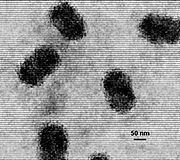Group Group I (dsDNA) Subfamily Chordopoxvirinae | Family Poxviridae Rank Genus | |
 | ||
Similar Chordopoxvirinae, Suipoxvirus, Capripoxvirus, Avipoxvirus, Orthopoxvirus | ||
Medical vocabulary what does molluscipoxvirus mean
Molluscipoxvirus is a genus of viruses, in the family Poxviridae, in the subfamily Chordopoxvirinae. Human serve as natural hosts. There are currently only one species in this genus: the type species Molluscum contagiosum virus. Diseases associated with this genus include: molluscum contagiosum: skin lesions.
Contents
Medical vocabulary what does molluscipoxvirus mean
Taxonomy
Group: dsDNA
Structure
Viruses in Molluscipoxvirus are enveloped, with brick-shaped geometries. Genomes are linear, around 190kb in length.
Life Cycle
Viral replication is cytoplasmic. Entry into the host cell is achieved by attachment of the viral proteins to host. Glycosaminoglycans (GAGs) mediates endocytosis of the virus into the host cell. The virion fuses with the plasma membrane to release the core into the host cytoplasm. Early phase: early genes are transcribed in the cytoplasm by viral RNA polymerase. Early expression begins at 30 minutes post-infection. Core is completely uncoated as early expression ends, viral genome is now free in the cytoplasm. Intermediate phase: Intermediate genes are expressed, triggering genomic DNA replication at approximately 100 minutes post-infection. Late phase: Late genes are expressed from 140 min to 48 hours post-infection, producing all structural proteins. Assembly of progeny virions starts in cytoplasmic viral factories, producing an spherical immature particle. This virus particle matures into brick-shaped intracellular mature virion (IMV). IMV virion can be released upon cell lysis, or can acquire a second double membrane from trans-Golgi and bud as external enveloped virion (EEV)host receptors, which mediates endocytosis. Replication follows the DNA strand displacement model. Dna templated transcription is the method of transcription. The virus exits the host cell by existing in occlusion bodies after cell death and remaining infectious until finding another host. Human serve as the natural host. Transmission routes are sexual and contact.
